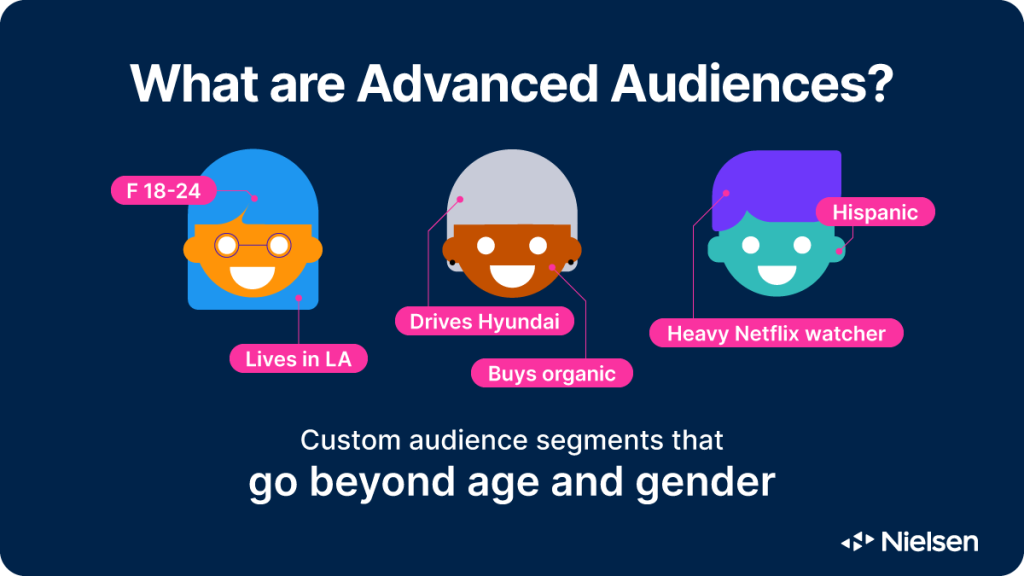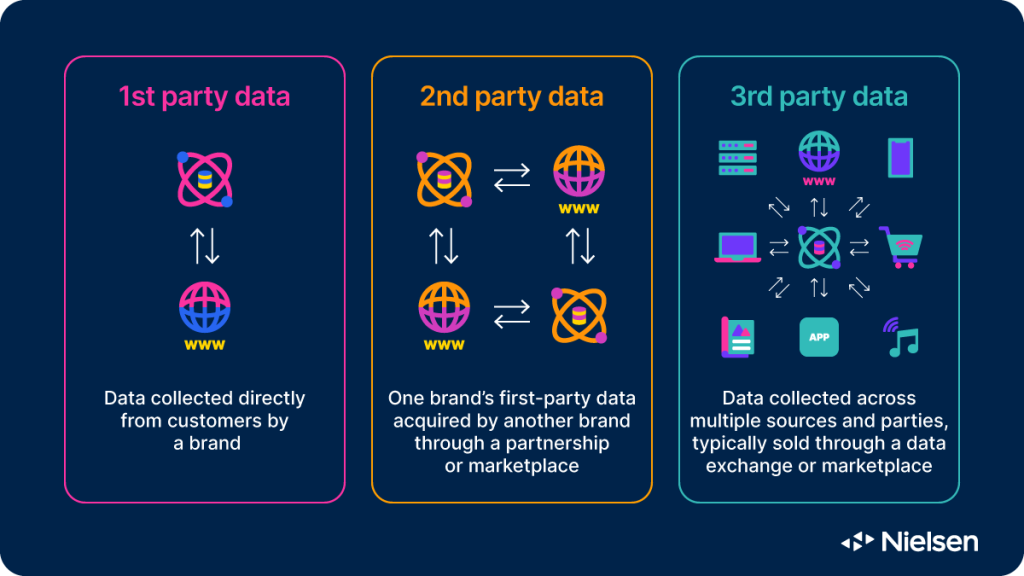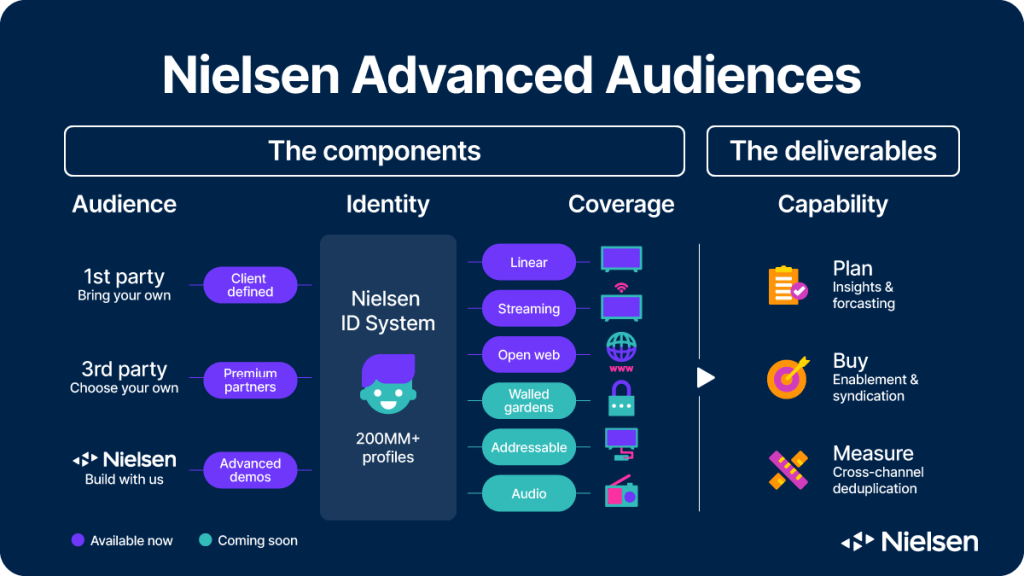Have you ever received an ad that felt incredibly specific? One that seems to understand exactly what stage of life you’re in and the kind of items you’re looking to buy? That is advanced audience targeting at work.
Follow along as we break down what advanced audiences are, why they matter and how they’re changing the ad world.
What’s an advanced audience?
In traditional media spaces, the standard demographic filters used to understand and reach audiences has been age and gender. Advanced audiences can go well beyond these basic demos.
Advanced audiences, sometimes called custom audiences, are consumer segments marketers use to group people together based on where they live, what they buy or intend to buy, how much money they make, the media they consume, the communities they’re part of, and so on. Marketers bring these audience lists to advertising platforms so they can reach them there with specific messaging.

The idea is that by narrowing down the group of recipients, you’re able to get hyper-targeted with your campaigns so they’re more likely to resonate. You increase effectiveness and reduce wasted spend by only reaching the folks who will likely care about what you’re selling, and you’re also able to see exactly how well campaigns performed within these groups. What you sacrifice in mass reach, you make up for in increased relevance.
Advanced audience segments are built from first, second or third-party data, or some combination of the three, which we’ll get into in the next section.
Once you have your advanced audience lists, you can build lookalike audiences that expand your initial group based on their commonalities. For example, if everybody in your initial advanced audience list cares about pets and uses TikTok, then a lookalike audience will include people who also care about pets and use TikTok.
What do you need to create advanced audiences?
Advanced audiences sound great, right? Now let’s look at how you actually build them.
The first and most important step is securing your data.

First-party data
First-party data is audience information collected directly from the consumer, by the brand.
Brands with the ability to collect their own audience data have an upper hand. Since it’s controlled by the brand and gathered straight from the source (in this case the audience), brands are able to easily expand what information gets captured with every channel interaction, new purchase, survey response or chatbot conversation.
The value of first-party data is exactly why so many brands create incentives for consumers to engage within their ecosystems. Sign up and get 20% off your next purchase. Create an account and see your personalized list of recommendations. Login to track your order delivery.
Second-party data
Of course, not every brand has access to first-party data. It may be hard to convince the general population to login into a soda provider’s website to order their next 12-pack. These brands may rely on second-party data, which is another’s company’s first-party data that’s acquired through a partnership.
Third-party data
While first and second-party data is collected directly from the audience, third-party data can come from several sources and is available for anyone to purchase. This is also the data pool most directly affected by the loss of cookies, forcing data providers to find reliable alternatives to digitally identify audiences.
By combining proprietary Nielsen audience data (we have tens of thousands of advanced audience segments) with first-party data from our partners, Nielsen helps brands get a more comprehensive view of their ideal consumer and sharpen their campaign targeting capabilities.
Insights are only as good as the data they’re built on. Since third-party data is gathered externally, brands should prioritize working with trusted partners who can prove the accuracy of what they deliver.
Once you have your audience data, you can create advanced audience lists and upload them across platforms to begin targeting your campaign creative. While this is a relatively straightforward and standardized process across most digital platforms, other channels are playing catch up.
Where can you use advanced audiences?
Advanced audience targeting first became a thing online thanks to the level of detail our digital footprints leave behind. Through digital identifiers, like usernames and browsing histories, marketers are able to tap into rich levels of consumer insight: who they are, what they want to consume and what they do after seeing an ad. All of these inputs help marketers create resonant campaigns for groups as niche as their data allows—informing everything from the creative to the timing and placement. It also helped digital platforms and publishers prove their ability to reach the exact audiences their clients cared about.
Traditional media like broadcast and cable may have unbeatable reach, but digital media is all about precision. At least that’s been the historical trade-off. But as the world has gone digital, there are new and heightened expectations for all channels to support the same level of audience addressability and performance accountability.
In the past decade, traditional media have carved out new outlets to dynamically address advertising to advanced audiences, like connected TV (CTV), free, ad-supported TV (FAST) channels and data-driven linear1. Still, there are foundational differences in how readily these channels can support planning and measuring against niche audience segments.
The next phase of advanced audiences will be ensuring standardized utility no matter the medium. This will require system overhauls to prioritize interoperability2— with the end goal being that the audience defined is the audience reached.
How do advanced audiences work at Nielsen?
Supporting this interoperability vision is at the heart of Nielsen’s strategy. We are acutely aware of the headaches a fragmented media environment creates for all sides of the media industry. It’s harder to reach specific audiences and manage how often they see your campaigns. Comprehensive planning and activation feels impossible as everything gets brought down to channel specifics.
But what if traditional media consistently operated with the same level of insight and personalization as digital? What if you could bring your own audiences to every platform and use them for planning, measurement and optimization?

Within the Nielsen ecosystem, you’re able to bring your own IDs or choose from audience segments developed from our cross-channel big data sets calibrated by gold-standard people panels. All audience data then goes through the Nielsen Identity System to ensure a deduplicated view of the audience across all screens and channels. What’s more, you’re able to reuse these audiences across all integrated Nielsen products and ensure audiences definitions are consistent across the entire user journey. Using the same defined audience, you’re able to build your media plans based on tailored insights and forecasting, purchase media, and get a deduplicated view of how well you reached your audience across channels.
Depending on where you are in the world, all of this is available today with Nielsen. But we are just getting started. Advanced audiences are now at the center of this brave, new advertising world, and Nielsen is here to help you thrive in it.
Nielsen’s Need to Know reviews the fundamentals of audience measurement and demystifies the media industry’s hottest topics. Read every article here.
Notes
1Data-driven linear is a process marketers use to allocate linear TV programming spend against demos beyond age and gender.
2Interoperability, in this instance, is when different technological systems interact with each other seamlessly. For example, being able to send and receive emails across all providers is interoperability at work.



